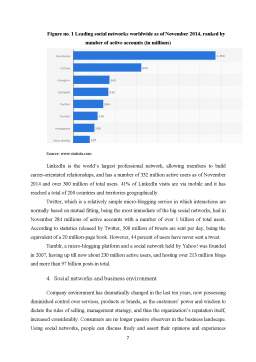Cuprins
- 1. Introduction 3
- 2. Social networks and social media – some definitions 4
- 3. Social networks – some facts and statistics 6
- 4. Social networks and business environment 7
- 5. Conclusions 11
- References 12
Extras din referat
1. Introduction
We live in a very shifting world. Fifty years ago, no one could anticipate the path that technology would have reached today, except, perhaps, for SF authors such as Isaac Asimov or, even earlier, Jules Verne. From the nascence of the internet, all information circulates at a very high level. We can find on the internet any information we need, from universal history to recipes, we can watch TV shows, e-mail, “surf the web” or just social-network with other persons. The number of internet users has increased considerably over the last decade due to its availability, improved connectivity and development of new technologies. According to the Internet World Stats , on June 30, 2014, the number of internet users was 3,035,749,340, which is almost 50% of the whole planet’s population. In 1995, it slouched at 1%, and between 1999 and 2013 the number of people who are connected to the internet has increased tenfold. This unprecedented evolution has been driven especially by the development and implementation of the capitalist philosophy, which is based on the private property of the means of production. The world became, as Thomas L. Friedman pointed out in his book, flat.
Given these, it has created a favorable framework for the apparition of the online communication platforms that are nowadays widely used for both personal and business purposes. They have radically changed the way people are communicating, connecting them across countries and regions. At the business level, many companies (SME firms, corporations) are currently moving from traditional media channels to social network sites, taking advantage of the opportunities they present and trying to understand how social media can bring value to businesses (they have even created special departments which investigate issues related to company’s image in the social-media field), thus being much closer to customers and knowing much better their needs and preferences. For the first time, the companies put the ball in the customers’ hands: they now understand that, in order to survive in this field of competition which is specific to market economy, they have to adapt to needs of their customers, not vice-versa. This proper digital era can easily be called the “customer revolution”.
Albeit the launch of many such social-networking platforms, at worldwide level only few sites are widely used, attracting people from around the world: Facebook, Twitter, LinkedIn and Google+.
2. Social networks and social media – some definitions
Encyclopedia of Information Science and Technology defines the social network as a small-world network, consisting of a set of individuals (persons, groups, organizations) connected by personal, work and trust relationships. They are usually modeled as graphs, where nodes correspond to social network members, whereas edges denote the relationships existing between them. Social-networking is then a quite broad and generic notion, which in the web context might be applied to any kind of virtual community. For instance, users registered to any Web service, such as Web mail, online journals, or newspapers requiring subscription, can be considered a social network.
For Kenneth C. Laudon and Jane P. Laudon social-networking is the practice of expanding the number of one’s business or social contact by making connections with individuals. Social networking sites link people through their mutual business or personal connections, enabling them to mine their friends (and their friend’s friends) for sales leads, job-hunting tips, or new friends. MySpace, Facebook, and Friendster appeal to people who are primarily interested in increasing their friendships, while LinkedIn.com focuses on job networking.
Members of social networking sites spend hours surfing pages, checking out other members, and exchanging messages, revealing a great deal of information about themselves. Businesses harvest this information to create carefully targeted promotions that far surpass the typical text and display ads found on the Web. They also use the sites to interact with potential customers.
In a nutshell, a social network represents a network of persons with mutual purposes and on these networks people around the world “meet” to communicate with each other quickly, to share various content, activities, states of mind, or to connect with diverse groups at the same time, to see and even to hear.
Preview document
Conținut arhivă zip
- The Impact of Social Networks On Business Environment.docx
























